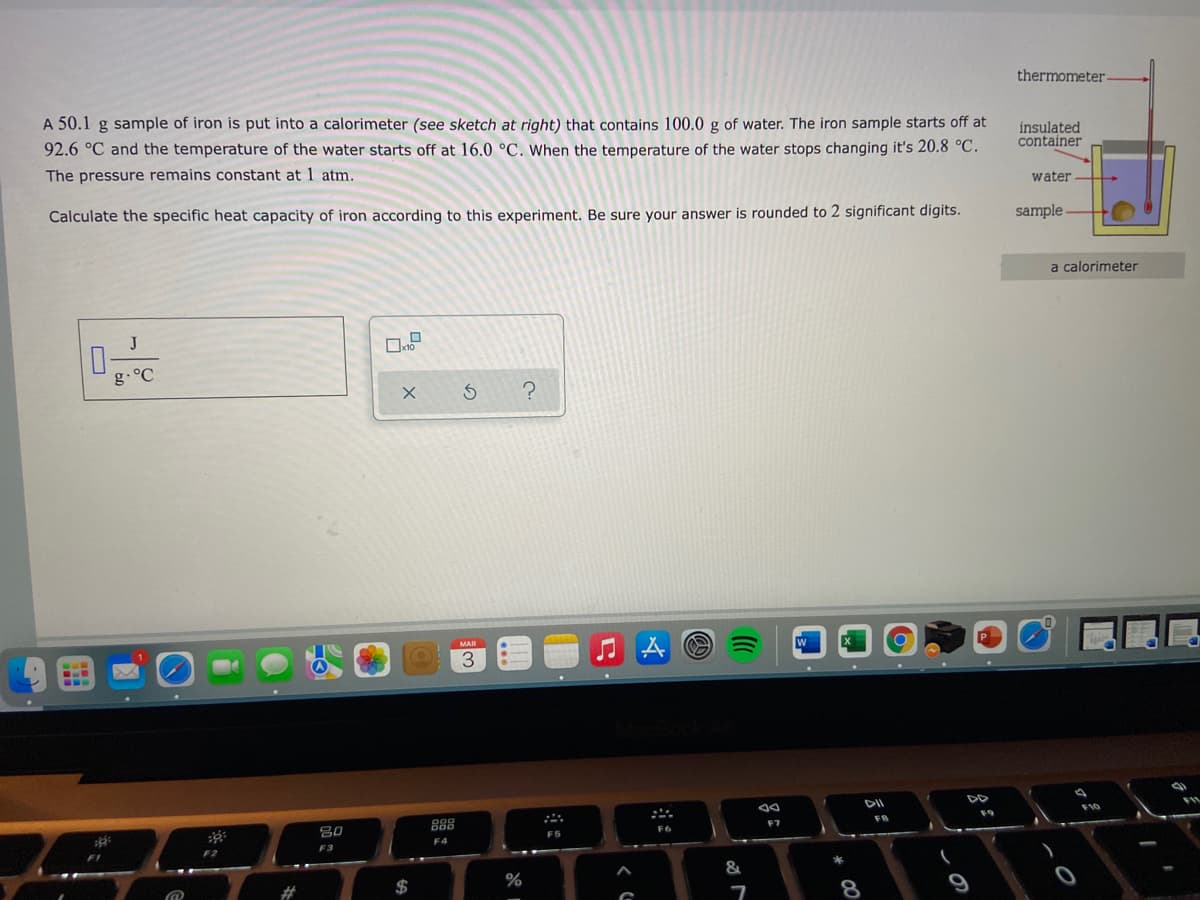A 50.1 g sample of iron is put into a calorimeter (see sketch at right) that contains 100.0 g of water. The iron sample starts off at 92.6 °C and the temperature of the water starts off at 16.0 °C. When the temperature of the water stops changing it's 20.8 °C. ins cor The pressure remains constant at 1 atm. sam Calculate the specific heat capacity of iron according to this experiment. Be sure your answer is rounded to 2 significant digits. J g. °C O
A 50.1 g sample of iron is put into a calorimeter (see sketch at right) that contains 100.0 g of water. The iron sample starts off at 92.6 °C and the temperature of the water starts off at 16.0 °C. When the temperature of the water stops changing it's 20.8 °C. ins cor The pressure remains constant at 1 atm. sam Calculate the specific heat capacity of iron according to this experiment. Be sure your answer is rounded to 2 significant digits. J g. °C O
Principles of Modern Chemistry
8th Edition
ISBN:9781305079113
Author:David W. Oxtoby, H. Pat Gillis, Laurie J. Butler
Publisher:David W. Oxtoby, H. Pat Gillis, Laurie J. Butler
Chapter12: Thermodynamic Processes And Thermochemistry
Section: Chapter Questions
Problem 14P
Related questions
Question

Transcribed Image Text:thermometer
A 50.1 g sample of iron is put into a calorimeter (see sketch at right) that contains 100.0 g of water. The iron sample starts off at
92.6 °C and the temperature of the water starts off at 16.0 °C. When the temperature of the water stops changing it's 20.8 °C.
insulated
container
The pressure remains constant at 1 atm.
water
Calculate the specific heat capacity of iron according to this experiment. Be sure your answer is rounded to 2 significant digits.
sample.
a calorimeter
J
g. °C
3
DII
DD
80
888
F10
F9
F7
FB
F5
F6
F4
F3
&
2$
8
9
Expert Solution
This question has been solved!
Explore an expertly crafted, step-by-step solution for a thorough understanding of key concepts.
This is a popular solution!
Trending now
This is a popular solution!
Step by step
Solved in 2 steps with 2 images

Knowledge Booster
Learn more about
Need a deep-dive on the concept behind this application? Look no further. Learn more about this topic, chemistry and related others by exploring similar questions and additional content below.Recommended textbooks for you

Principles of Modern Chemistry
Chemistry
ISBN:
9781305079113
Author:
David W. Oxtoby, H. Pat Gillis, Laurie J. Butler
Publisher:
Cengage Learning

Chemistry for Engineering Students
Chemistry
ISBN:
9781337398909
Author:
Lawrence S. Brown, Tom Holme
Publisher:
Cengage Learning

Chemistry
Chemistry
ISBN:
9781305957404
Author:
Steven S. Zumdahl, Susan A. Zumdahl, Donald J. DeCoste
Publisher:
Cengage Learning

Principles of Modern Chemistry
Chemistry
ISBN:
9781305079113
Author:
David W. Oxtoby, H. Pat Gillis, Laurie J. Butler
Publisher:
Cengage Learning

Chemistry for Engineering Students
Chemistry
ISBN:
9781337398909
Author:
Lawrence S. Brown, Tom Holme
Publisher:
Cengage Learning

Chemistry
Chemistry
ISBN:
9781305957404
Author:
Steven S. Zumdahl, Susan A. Zumdahl, Donald J. DeCoste
Publisher:
Cengage Learning

Chemistry: An Atoms First Approach
Chemistry
ISBN:
9781305079243
Author:
Steven S. Zumdahl, Susan A. Zumdahl
Publisher:
Cengage Learning


Chemistry & Chemical Reactivity
Chemistry
ISBN:
9781133949640
Author:
John C. Kotz, Paul M. Treichel, John Townsend, David Treichel
Publisher:
Cengage Learning